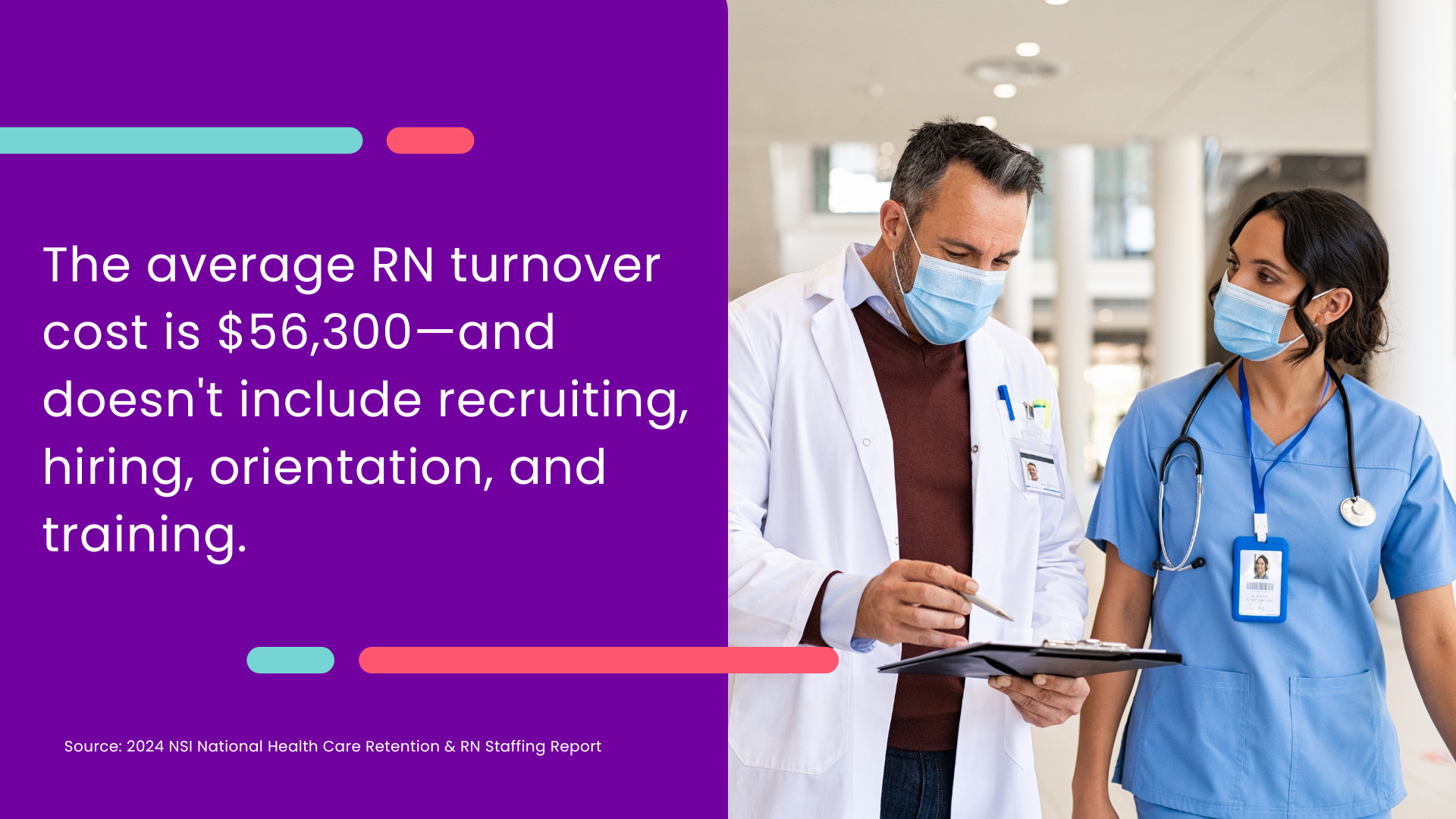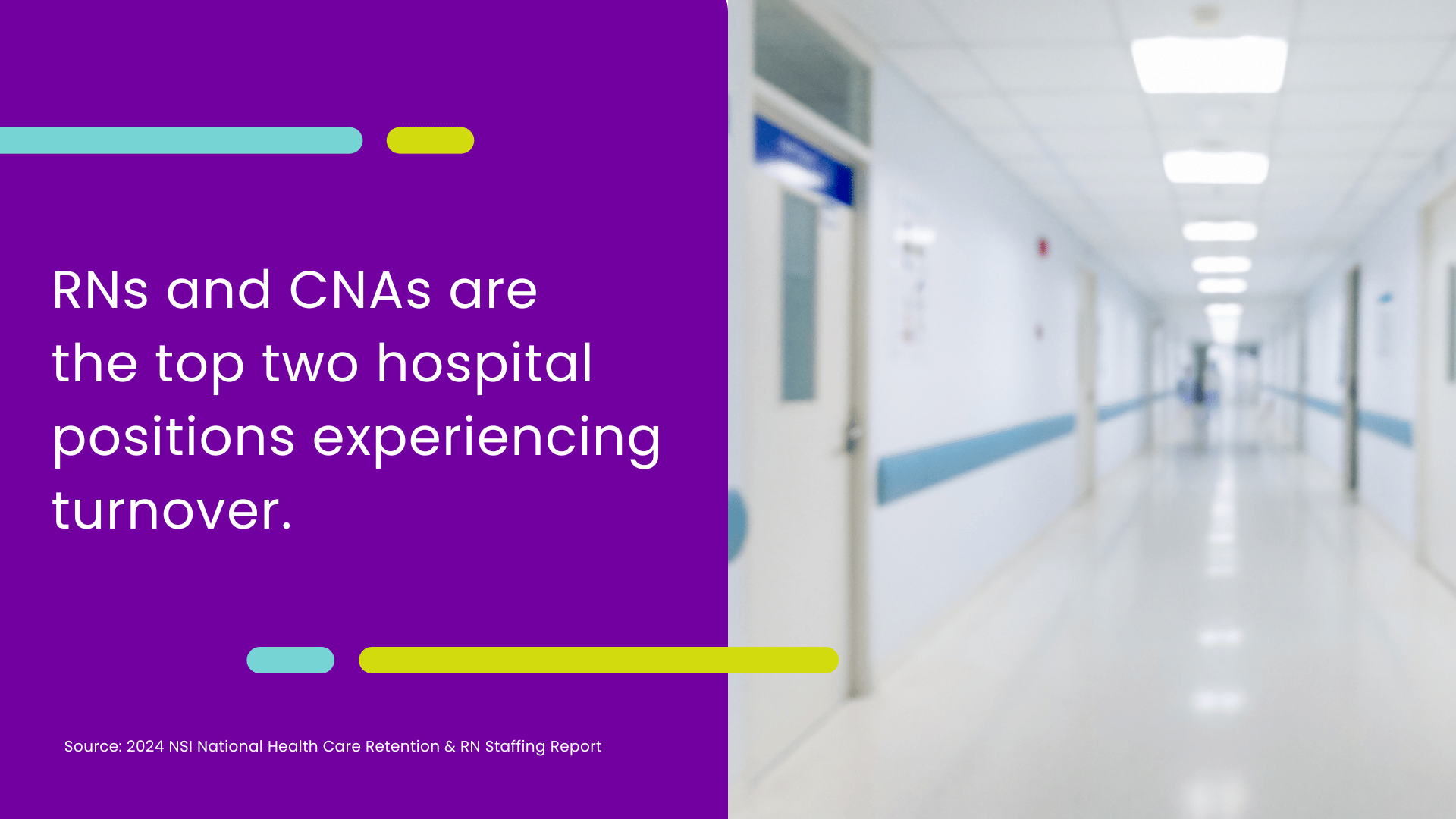
Nursing faces an imminent crisis, with over 610,000 RNs projected to exit the profession by 2027 due to stress, burnout, and retirement. This exodus poses a significant threat to patient care nationwide, demanding urgent attention from hospital and health system leaders.
NCSBN research from 2023 suggests that nurse workloads and burnout levels during the COVID-19 pandemic helped accelerate the departure, particularly for younger, less experienced RNs. Additionally, the 2024 NSI National Health Care Retention & RN Staffing Report shows that RNs voluntarily resign for reasons involving scheduling, working conditions, and staffing ratios.
To get ahead of the crisis, hospitals must prioritize the well-being of their nurses today to secure a resilient, sustainable workforce for the future. They must step away from traditional staffing practices and rethink their nursing workflow model to include a mix of mechanisms, such as flexible scheduling options and on demand staffing, to improve working conditions for nurses.
McKinsey and Company conducted several frontline nursing surveys and found meaningful work and flexible schedules among the most influential factors in getting RNs to stay in their positions.

Healthcare Leaders Discuss On Demand Staffing
In the AONL webinar Unlock Nursing Operational Success with Flexible Staffing, Jay Sundheimer, Chief Nurse Executive at Presbyterian Healthcare Services, and Jessica Potts, System Senior Director of Strategic Workforce Operations at SSM Health, discussed the different mechanisms and strategies their organizations use to build talent pipelines—with on demand staffing being among them.
On Demand Healthcare at Presbyterian Healthcare Services
Despite implementing nurse residencies, fellowships, strategic pipelines, and school partnerships, including innovative programs like "school in a box," Sundheimer explained these mechanisms weren't enough to activate and fill every open shift within Presbyterian Healthcare Services.
However, that changed when Presbyterian teamed up with ShiftMed in September 2023 and started orientation for the first ShiftMed on demand cohort in October. Within four months, Presbyterian onboarded more than 200 ShiftMed nurses, with active clinicians working an average of 5.77 shifts monthly. ShiftMed nurses fill scheduling gaps in four Presbyterian facilities and will integrate into additional locations over time.
"On demand is helping us build the workforce sustainability we need," said Sundheimer. "It's amazing what you can do with adequate staffing and how many patients you can care for in unique settings."
He also noted that ShiftMed has played a role in Presbyterian's efforts to reduce reliance on travel nurses, helping to eliminate the need for travelers within its inpatient operations.
Furthermore, the flexibility offered by the ShiftMed nursing jobs app engages a previously untapped pool of local nurses outside the Presbyterian network. Nurses who were previously hesitant to commit to a PRN position with Presbyterian can now claim shifts on their terms through the app, making it easier for Presbyterian to attract skilled, capable nurses to fill gaps.
Learning something new with each ShiftMed facility integration, Sundheimer said the organization looks for nuances they hadn't explored before. For example, when the organization told its internal nurses about using on demand healthcare staffing to fill shift vacancies, he said many employees voiced that they wanted flexible scheduling opportunities similar to ShiftMed workers.
"We're hearing the desire to be as flexible as gig nursing but within our employed workforce," he said. "So, we're exploring building an internal structure to be as flexible as our nurses demand."

On Demand Healthcare at SSM Health
According to Potts, SSM Health's labor strategy is also comprehensive. It encompasses various approaches to tap into new talent pools, with on demand staffing being one piece of the puzzle.
For example, SSM Health relied heavily on high-cost contingent labor, including 1099 contractors, to get through the pandemic, making it difficult to recover and get staffing closer to where it was pre-pandemic. So, given the financial and legal challenges associated with that approach, SSM Health joined forces with ShiftMed in July 2023 to access local W-2 nurses available to work on demand.
SSM Health has nearly 3,000 ShiftMed nurses working shifts within its acute care ministries. For instance, ShiftMed nurses claimed almost 6,000 shifts in January 2024. Leaving Potts to comment, "Where would we be if ShiftMed didn't help us fill those shifts?"
According to Potts, they use credentialed ShiftMed RNs, LPNs, CNAs, and respiratory therapists to fill gaps in critical care, medical-surgical, behavioral health, and emergency. SSM Health has also implemented a handful of ShiftMed nurses into some of its post-acute facilities.
"We use our on demand pool of ShiftMed nurses as an extension of our regional float pools. For instance, if a med-surg nurse is scheduled at one ministry but we realize we need them at another nearby one, we can switch their assignment."
Furthermore, SSM Health keeps close tabs on shifts in labor market priority. "One of the most common trends we're seeing today is the need for flexibility," said Potts. "So, we've done a lot of work to respond to that new priority, with on demand being a big part of that."

Why Choose On Demand Staffing for Your Hospital?
ShiftMed On Demand Healthcare solutions take a flexible staffing approach that allows credentialed nurses in your community to fill shifts at your hospital on demand.
These nurses are ShiftMed W-2 employees, meaning we're responsible for them while working at your facility. From handling their payroll to verifying their credentials, we handle everything as their employer of record.
Increase your shift fulfillment rates using the local latent workforce. On demand staffing enables you to leverage the latent nursing workforce within your community. By tapping into our on demand healthcare workforce, you can fill shift vacancies almost immediately with credentialed, locally-based nurses who exhibit a sense of ownership that's different from travelers.
Quickly adapt to fluctuating patient volumes and acuity levels. Traditional staffing models make it difficult to adjust to changes in patient volumes. Our on demand platform offers flexibility, enabling you to scale your workforce up or down as needed, ensuring optimal staffing levels without overburdening internal staff.
Attract credentialed nurses to your facility without paying recruitment costs. Beyond filling staffing gaps, on demand staffing can serve as a bridge-to-hire solution. You can nurture potential candidates and seamlessly transition them to permanent positions without paying high recruitment costs or a buy-out fee.
Save on labor costs by reducing your reliance on travel nurse contracts. On demand staffing can help your hospital reduce its dependency on costly travel nurses. Unlike traditional staffing approaches that lock facilities into fixed commitments, on demand doesn't involve long-term contracts, so you can align your staffing costs with patient census and operational demands.
Enhance nurse job satisfaction and reduce staff turnover. Nurse burnout levels are at an all-time high. By using on demand nurses to carry some of the workload, you can give your nursing staff the time off they want, need, and deserve. Giving your employees a better work-life balance improves their job satisfaction and helps you retain top talent.
Boost your scheduling efficiency via an AI-driven platform. Our AI-driven on demand platform eases administrative burdens and eliminates manual tasks associated with nurse scheduling. The technology also optimizes resource allocation, streamlines workflows, and enhances decision-making processes.
Enhance on-the-job training and support for your new nurse recruits. When heavy workloads burden experienced nurses, there's little time available for training new recruits, which can leave novice nurses feeling frustrated and ill-prepared for their roles. By using on demand nurses to assist with routine tasks, you can free up your seasoned staff to help train new nurses.
Conclusion
In the face of a looming nursing crisis, hospitals must proactively adapt their staffing strategies to ensure the well-being of their nurses and the quality of patient care.
On demand staffing emerges as a vital solution, offering flexibility, efficiency, and cost-effectiveness that traditional models struggle to provide. The success stories shared by Presbyterian Healthcare Services and SSM Health in the AONL webinar serve as compelling evidence of its efficacy.
So, as your hospital navigates the evolving landscape of healthcare staffing, prioritizing on demand solutions can safeguard the resilience of your workforce and the well-being of your patients.
Discover what ShiftMed On Demand Healthcare can do for your hospital staffing. Book a demo today!